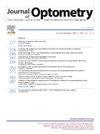Evidence on the parameters of oculomotor skills and normative values: A systematic review
IF 1.8
Q2 OPHTHALMOLOGY
引用次数: 0
Abstract
Purpose
To evaluate the current evidence on oculomotor measurement parameters and their normative values through a systematic review.
Methods
A search of primary studies was conducted using a search equation with free language. Original articles analyzing normal oculomotor function parameters in healthy populations of any age, studies that included a clearly differentiated healthy control group, and articles using any oculomotor measurement test were included. The QUADAS-2 tool was used to assess the risk of bias, applicability, and quality of the studies. The review was conducted independently by the authors and then pooled to determine the final inclusion.
Results
A total of 915 articles were identified, of which 750 were excluded after the first review of the title and abstract. In the second step, 133 out of 165 investigations were discarded. Ultimately, 32 articles from the initial search were included, along with 10 additional articles identified through a manual search. The findings revealed variations in how oculomotor skills are measured, including differences in stimuli, measurement distances, and parameters assessed. A high risk of bias was observed (≥50 % in the areas of “flow and timing”, “reference standard” and “patient selection”) along with poor applicability (≥50 % in all aspects).
Conclusions
There is no clear evidence on normative values for oculomotor skills, nor is there a consensus on the measurement methods, stimulus used, or working distance. Furthermore, there is no agreement on which aspects of oculomotor skills should be assessed. To enhance reliability and applicability, measurement criteria should be standardized, and normative values should be established.
关于动眼力技能参数和规范值的证据:系统回顾
目的通过系统综述,评价目前有关动眼肌测量参数及其规范性值的证据。方法利用自由语言检索方程对初步研究进行检索。分析任何年龄健康人群正常动眼肌功能参数的原创文章,包括明确区分的健康对照组的研究,以及使用任何动眼肌测量测试的文章。使用QUADAS-2工具评估研究的偏倚风险、适用性和质量。该综述由作者独立进行,然后汇总以确定最终的纳入。结果共筛选到915篇文献,其中750篇经标题和摘要一审后被排除。在第二步中,165个调查中有133个被放弃。最终,从最初的搜索中包含了32篇文章,以及通过手动搜索确定的另外10篇文章。研究结果揭示了动眼肌技能测量方法的差异,包括刺激、测量距离和评估参数的差异。观察到高偏倚风险(在“流量和时机”、“参考标准”和“患者选择”领域≥50%)以及较差的适用性(在所有方面≥50%)。结论没有明确的证据表明动眼肌技能的规范性值,在测量方法、使用的刺激或工作距离上也没有共识。此外,对于动眼力技能的哪些方面应该进行评估,目前还没有达成一致意见。为提高可靠性和适用性,应规范计量标准,建立标准值。
本文章由计算机程序翻译,如有差异,请以英文原文为准。
求助全文
约1分钟内获得全文
求助全文

 求助内容:
求助内容: 应助结果提醒方式:
应助结果提醒方式:


